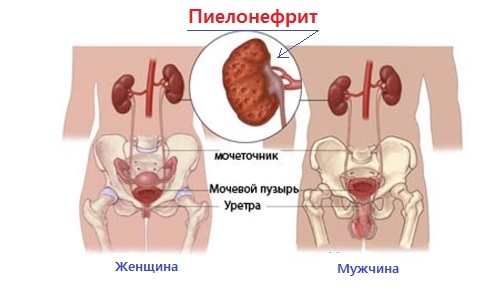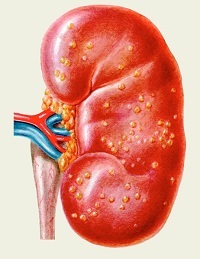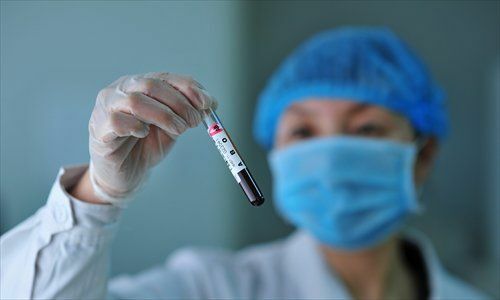Renal pyelonephritis is considered to be a disease with an infectious inflammatory focus of development, in which serious damage to the renal pelvis and its own tissue occurs. Often, the direct sources of the disease are different families of bacteria( such can be enterococci or staphylococcus), as well as a number of others: urolithiasis, glomerulonephritis. Based on the nature of the lesion and clinical manifestations, pyelonephritis can be chronic, acute, purulent.

What are the causes of pyelonephritis?
To determine exactly the causative agent of pyelonephritis is quite a difficult task even today, because in some cases endogenous factors, that is, human own microorganisms, in others - exogenous, that penetrate the body from outside, can act as such. However, a greater percentage of pyelonephritis is due to Escherichia coli and cocci.
The disease can affect everyone, however, many years of experience of doctors shows that the majority of patients with pyelonephritis still have female representatives. This state of affairs is directly related to the maximum pressure of the kidneys and ureters of the fetus during pregnancy, due to which the urine begins to stagnate.
Warning! With long-term stagnation of urine, an environment favorable for reproduction of infections is created with the subsequent development of the inflammatory process.
The risk group also includes:
- small children under 7 years of age, the development of the disease in which is due to the anatomical features of their body;
- young girls, whose development of kidney pyelonephritis is due to the onset of sexual activity;
- men of advanced age, suffering for several years adenoma of the prostate gland, which has passed into a chronic form.
There are two main factors contributing to the development of kidney pyelonephritis:
- common;
- local.
Common factors are caused by:
- chronic stress, long-term stay of the patient in nervous tension;
- with a constant sense of weakness, loss of strength, inability to perform complex physical work;
- acute deficiency in the body of certain vitamin and mineral substances;
- physical overwork;
- with diabetes mellitus;
- weakened immunity due to frequent colds or infectious diseases.
The basis of local factors are pathological conditions, the presence of which contributes to the appearance of a barrier for the natural outflow of urine.
The penetration of bacteria and viruses into the kidney is carried out by urogenital, lymphogenous and hematogenous pathways. Urogenous infection occurs directly through the urine, lymphogenous - through the lymph coming from the organs and tissues affected by bacteria, hematogenous - through the blood.
Forms of kidney pyelonephritis development
 Pyelonephritis is characterized by acute, chronic and purulent development, each of which has its own signs of manifestation. Acute has a pronounced symptoms, which can not be noticed, impossible, suddenly manifested, characterized by rapid development. Depending on what factor has become the causative agent of pyelonephritis, the form in question can last for 20 days. Unlike other forms, the success of treatment is observed precisely when acute, as the patient turns to the doctor at the very beginning of her development, when sudden severe pain is taken by surprise.
Pyelonephritis is characterized by acute, chronic and purulent development, each of which has its own signs of manifestation. Acute has a pronounced symptoms, which can not be noticed, impossible, suddenly manifested, characterized by rapid development. Depending on what factor has become the causative agent of pyelonephritis, the form in question can last for 20 days. Unlike other forms, the success of treatment is observed precisely when acute, as the patient turns to the doctor at the very beginning of her development, when sudden severe pain is taken by surprise.
For the chronic form of pyelonephritis of the kidneys are characterized by a lingering course, with periodic exacerbations in case of non-compliance with diet, lack of timely treatment, hypothermia. Chronic is dangerous in that as a result healthy kidney tissues are involved in the process of festering - there is a danger of permanent damage to the entire kidney.
As for purulent development of kidney pyelonephritis, the causes are the chronic form of the disease or other problems affecting the genito-urinary system of the patient. Purulent pyelonephritis is exposed mainly to people who are already in 30 years, launching the disease at the very beginning of its development. At this stage of the disease, adipose tissue lesions occur, which adheres directly to the diseased kidney.
Symptoms of the disease
Symptoms in kidney pyelonephritis depend on its shape. Patients with acute form are observed:
- , apparent changes found in the urine - a cloudy or slightly reddish hue, causticity and offensiveness;
- stupid, and sometimes acute pain in the joints or lumbar region, which increases when trying to lean forward;
- nausea, worse after eating;
- spontaneous vomiting;
- sudden temperature rise;
- fever;
- headache, which may worsen with minor changes;
- decrease or total lack of appetite;
- general weakness.
Chronic kidney pyelonephritis can be hidden or recurrent. When hidden, the temperature rarely rises, but if it is, it lasts long enough. Recurrent pyelonephritis proceeds with a slight weakness, attacks of dizziness, changes in the urine, not specific to the patient.
Diagnosis methods for pyelonephritis
Diagnosis consists of:
- urine analysis;
- blood test;
- instrumental research methods.
The analysis of blood reveals the presence of common inflammatory processes that take place in the patient's body. Due to the analysis of urine, it is possible to identify the causative agent with the subsequent determination of its sensitivity to specific antibiotics. Instrumental same examination helps to see the condition of the kidneys, whether there is a purulent process, whether immediate surgical intervention is required.
Treatment of kidney pyelonephritis
Treatment of kidney pyelonephritis implies:
- strict adherence to diet;
- conducting medical therapy;
- methods of surgical intervention.
What should be the diet?
With kidney pyelonephritis, a strict diet should be observed, which contributes to the outflow of urine and the removal of infections. Compliance with the diet implies an increase in the number of consumed liquids per day, the rejection of harmful food, that is, the patient should exclude fried, buttery, baked, fatty, spicy, salty foods. This includes the refusal of fresh bread, French rolls, strong meat broths, as well as those foods that can cause a sharp taste sensations. Speaking about the increase in consumed liquid, it is understood that patients over 16 years old must drink up to 2 liters of water, children aged 8-16 years - 1.5 liters of water, children up to 8 years - 1 liter.
Treatment with medicines
The method of drug treatment for kidney pyelonephritis consists of taking those drugs that are aimed at the maximum destruction of the infections that caused the inflammatory process. Usually the course of treatment with antibiotics is 7 days, in more complex cases - about a month.
Surgical method of treatment
Surgical method of treatment of pyelonephritis is used in extreme cases, when neither the diet nor the medicines give the expected results. The pursued goal of surgical treatment is to prevent the development of the purulent and inflammatory process of the diseased kidney as much as possible, and also to prevent its appearance as yet in a healthy one. If the examination reveals a violation of the natural outflow of urine, then by surgery this defect is excluded.
What is the danger of pyelonephritis?
Any disease provoked by an infectious inflammatory focus that has not been treated in a timely manner can lead to a number of complications. In this case, the consequences of pyelonephritis of the kidneys can be the following:
- the transition of acute, untreated pyelonephritis in time to chronic relapse;
- occurrence of the process of suppuration, which threatens to subsequently remove the diseased kidney.
Taking into account these consequences, the patient should approach pyelonephritis of the kidneys with all the responsibility, especially when you consider that this disease in some cases occurs without any acute symptoms. Timely detected pyelonephritis and well-selected treatment will help in a fairly short time to get rid of the severe symptoms of an insidious disease.
Prophylactic measures for kidney pyelonephritis
Those persons who have a tendency to kidney diseases, in particular pyelonephritis of the kidneys, must necessarily observe a number of preventive measures aimed at preventing the recurrence of the disease. Speaking about prevention, it should be noted that it is quite simple, it only requires responsibility, especially in the case of children. Measures of prevention are:
- use of a certain amount of fluid per day, which contributes to the withdrawal of urine;
- exclusion of delay in the process of urination, which occurred during exacerbation;
- timely and complete treatment of existing infectious diseases, which are direct sources of pyelonephritis;
- elimination of supercooling sources;
- carefully observe the basic rules of personal hygiene;
- commitment to maintaining a healthy lifestyle, including general restorative therapy, moderate exercise, balanced diet, periodic intake of vitamin and mineral complex;
- regular follow-up with the attending physician-urologist;
- periodic delivery of urine for analysis.
Know that a timely visit to a urologist, careful observation of preventive measures, as well as listening to non-organism-specific symptoms will ensure the full health of a person for many years!



